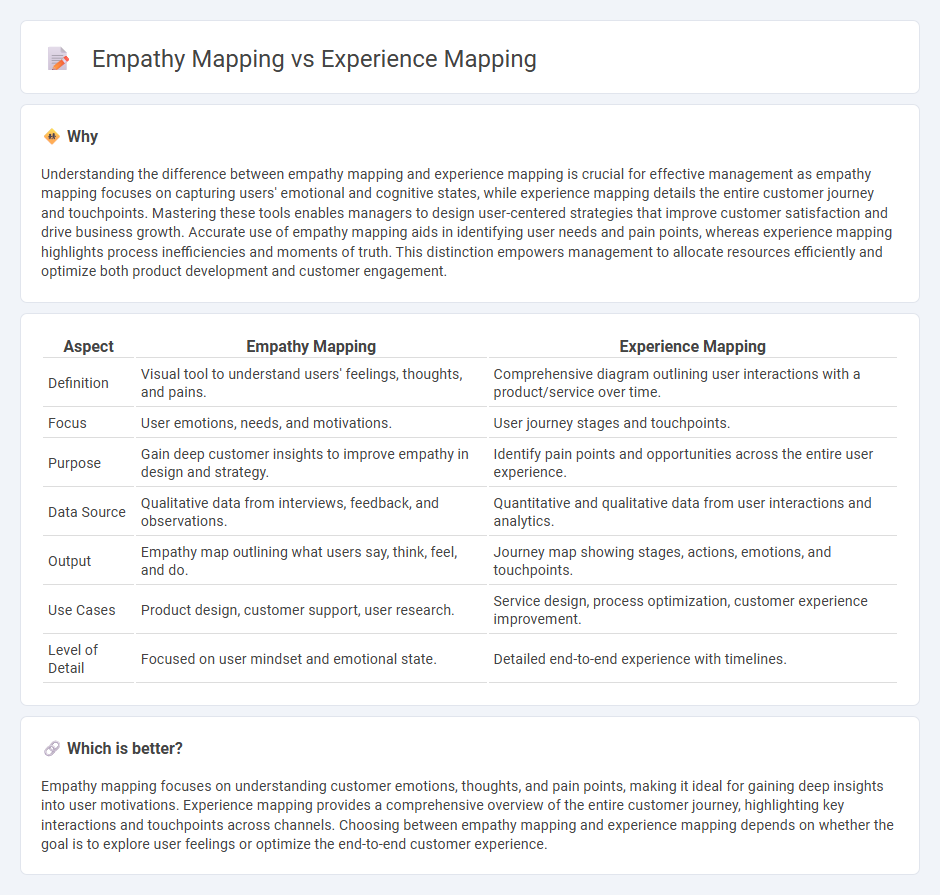
Empathy mapping focuses on understanding customers' feelings, thoughts, and motivations during their interaction with a product or service, while experience mapping provides a comprehensive visual representation of the entire customer journey across multiple touchpoints. Both tools are essential in user-centered design and service management to enhance customer satisfaction and business outcomes. Explore more to discover how these approaches drive strategic decision-making and innovation.
Why it is important
Understanding the difference between empathy mapping and experience mapping is crucial for effective management as empathy mapping focuses on capturing users' emotional and cognitive states, while experience mapping details the entire customer journey and touchpoints. Mastering these tools enables managers to design user-centered strategies that improve customer satisfaction and drive business growth. Accurate use of empathy mapping aids in identifying user needs and pain points, whereas experience mapping highlights process inefficiencies and moments of truth. This distinction empowers management to allocate resources efficiently and optimize both product development and customer engagement.
Comparison Table
| Aspect | Empathy Mapping | Experience Mapping |
|---|---|---|
| Definition | Visual tool to understand users' feelings, thoughts, and pains. | Comprehensive diagram outlining user interactions with a product/service over time. |
| Focus | User emotions, needs, and motivations. | User journey stages and touchpoints. |
| Purpose | Gain deep customer insights to improve empathy in design and strategy. | Identify pain points and opportunities across the entire user experience. |
| Data Source | Qualitative data from interviews, feedback, and observations. | Quantitative and qualitative data from user interactions and analytics. |
| Output | Empathy map outlining what users say, think, feel, and do. | Journey map showing stages, actions, emotions, and touchpoints. |
| Use Cases | Product design, customer support, user research. | Service design, process optimization, customer experience improvement. |
| Level of Detail | Focused on user mindset and emotional state. | Detailed end-to-end experience with timelines. |
Which is better?
Empathy mapping focuses on understanding customer emotions, thoughts, and pain points, making it ideal for gaining deep insights into user motivations. Experience mapping provides a comprehensive overview of the entire customer journey, highlighting key interactions and touchpoints across channels. Choosing between empathy mapping and experience mapping depends on whether the goal is to explore user feelings or optimize the end-to-end customer experience.
Connection
Empathy mapping and experience mapping are interconnected tools in management that focus on understanding customer needs and behaviors to enhance service design and user experience. Empathy mapping captures customers' feelings, thoughts, and pain points, while experience mapping visualizes the entire customer journey across touchpoints, identifying moments of friction or delight. Integrating these approaches enables managers to align business strategies with authentic user insights, driving customer-centric innovation and improved satisfaction.
Key Terms
Customer Journey (Experience Mapping)
Experience mapping captures the entire Customer Journey, detailing each interaction point and emotional state from initial awareness to post-purchase engagement. This map highlights pain points, opportunities, and moments of delight across multiple channels, providing a holistic view of customer behavior and expectations. Explore how experience mapping can transform your understanding of customer journeys for improved service design and satisfaction.
User Emotions (Empathy Mapping)
Empathy mapping centers on capturing and understanding user emotions, thoughts, and experiences to build a deeper connection with the user's perspective. Experience mapping, meanwhile, provides a broader view of the entire user journey, including interactions, pain points, and touchpoints across various stages. Explore more about how empathy mapping enhances user-centered design and emotional engagement.
Touchpoints (Experience Mapping)
Experience mapping emphasizes identifying and analyzing touchpoints where users interact with a service or product, highlighting moments that shape overall customer perception. Touchpoints include every channel and interface, such as websites, customer support, and social media, contributing to the user's journey. Explore more insights on optimizing touchpoints within experience mapping.
Source and External Links
Customer Experience Mapping: What Is It And How To Do It - This article explains what customer experience mapping is and how startups can use it to improve their users' experiences.
How To Build an Experience Map - This guide outlines the process of creating an experience map to visualize a customer's journey and identify opportunities for innovation.
What is User Experience Mapping? - This article describes user experience mapping as a technique for understanding customer needs, hesitations, and concerns across various touchpoints.
 dowidth.com
dowidth.com